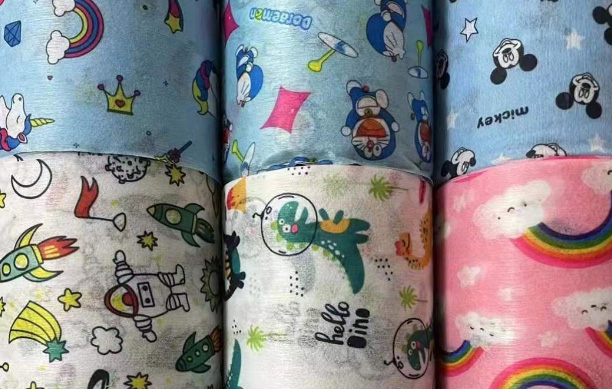Summary: Nonwoven fabrics are made by tangli...
Nonwoven fabrics are made by tangling fibres together to form a textile structure. These materials are strong and durable and are used in a variety of applications including medical products, geotextiles, furniture, and roofing. They are typically made from a combination of fibres, including staple fibres. Some types of nonwoven fabrics are woven by mechanical means, such as needlepunching, stitchbonding, and hydroentangling. Some nonwoven fabrics are woven by chemical means, such as stable foam bonding, airless spraying, and saturation. The methods used depend on the binder and the compatibility of the fibres.One type of nonwoven fabric is made from wool. Felt is made by tangling the fibers of wool together. It was the first textile created by man, and it is still used today mostly in hats and mittens. This type of fabric can be made into various weights and textures, and is easy to manufacture.
Printed Mask Spunlace Nonwoven Fabric Roll Goods
Nonwoven fabrics are three-dimensional structures made of fibers that are arranged in a certain pattern. The fiber structure and alignment are crucial for the filtration properties of these materials. Therefore, it is essential to study the microstructure of these materials using new imaging methods. One method, known as the depth from focus technique, is used to characterize nonwoven fabrics. It consists of using a self-developed micro imaging system to take an image sequence of a nonwoven fabric specimen and then generating a depth map based on these images.Depending on the type of nonwoven fabric, it may include a first surface and a second surface. The first surface may be visually discernible and contain three-dimensional features that define microzones.
These features can differ in volumetric density, thickness, or basis weight. In addition, the nonwoven fabric may include at least one surface with a TS7 value less than 15 dB V2 rms.Nonwoven fabrics are versatile, strong, and durable. They have a wide range of uses, including textiles, apparel, and automotive applications. Nonwovens are also useful for insulation, filtration, and protection. They are also able to resist fire and moisture. In addition to being durable, nonwovens also provide several other benefits, such as softness and stretchability.Nonwoven fabrics can be made from various types of fibres.
Among these, new and first-quality filament fibres are preferred over recycled fibres. Staple fibres can also be used. The fibres can be of different lengths and generic groups. The cost of these fibres is a major factor in the cost of the final product.Nonwovens are widely used in home and industrial applications. Their elasticity, softness, and durability make them superior to rigid polyester and polypropylene fibers. For example, a single layer of nonwoven fabric can replace the inner layer of a double-layered diaper. In addition to this, nonwovens can be used to produce thin, high-filtration fabrics. Researchers are continuing to find ways to create nonwovens that will match the properties of conventionally constructed cloth.
